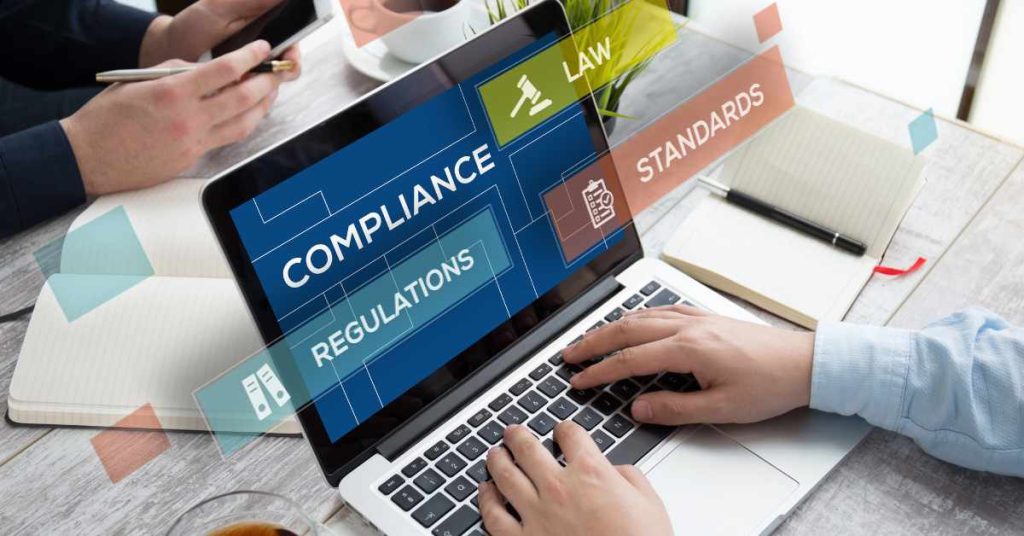HR compliance is more than a legal requirement—it’s a strategic function that protects your organization, enhances employee trust, and drives long-term business success. In a world where labor laws are becoming more complex and employee expectations are rapidly evolving, compliance is no longer just an HR task; it’s a company-wide commitment.
This comprehensive guide explains how to achieve compliance in HR, highlights common risks, and provides a detailed HR compliance checklist to help you stay aligned in 2025.
What is HR compliance?
HR compliance is the process of ensuring that an organization’s HR policies, procedures, and practices are aligned with applicable laws, regulations, and ethical standards. It covers everything from fair labor practices and workplace safety to data privacy and non-discrimination policies.
Compliance HR professionals play a critical role in preventing violations, managing risk, and creating a culture where employees feel safe, respected, and fairly treated.
Overview of Common HR Compliance Issues
HR compliance is a critical, multifaceted responsibility that requires constant vigilance as regulations evolve and workplace practices change. Below is an expanded look at the most common HR compliance issues businesses face today, with practical examples and recent trends.
Wage and Hour Compliance
- Businesses often struggle with correctly classifying employees as exempt or non-exempt under the Fair Labor Standards Act (FLSA), accurately tracking hours worked, and ensuring proper overtime pay. Mistakes here can result in significant financial penalties and lawsuits. For example, a recent federal court verdict required a company to pay over $22 million for wage and hour violations 9.
- Companies must also stay current with changes in minimum wage laws at both the federal and state levels, as these can shift frequently 7.
- If you employ people in multiple locations, you must check which state and local employment laws apply, since wage and hour rules can differ significantly by jurisdiction 6 7.
Harassment and Discrimination
- Failure to implement clear anti-harassment and anti-discrimination policies, or to provide sufficient HR compliance training, can lead to violations of equal opportunity laws such as Title VII of the Civil Rights Act and the Americans with Disabilities Act (ADA) 5 9.
- Discriminatory hiring practices, such as biased job postings or inappropriate interview questions, can expose your business to legal action. Companies are increasingly expected to demonstrate equitable hiring, promotion, and pay practices as diversity, equity, and inclusion (DEI) standards become compliance requirements in many regions 7 9.
Improper Employee Classification
- Misclassifying independent contractors as employees (or vice versa) can result in tax penalties, wage claims, and audits from labor departments 5 8.
- Example of non-compliance: If a marketing agency hires a graphic designer as an independent contractor but requires them to work fixed hours under close supervision, this worker may legally be considered an employee and entitled to benefits. Misclassification in such cases can lead to fines and back pay liabilities.
- Businesses need to understand which employees are eligible for which benefits and what their wages should be based on hours worked and location to stay compliant with classification rules 5 6.
Benefits Mismanagement
- Failing to provide mandated benefits such as COBRA, Family and Medical Leave Act (FMLA), or Affordable Care Act (ACA)-compliant health coverage can expose employers to federal penalties 5.
- Multistate or global operations must also track country- or state-specific requirements for paid leave, health insurance, and other statutory benefits6.
Remote and Hybrid Workforce Gaps
- The rise of remote and hybrid workforces introduces new compliance challenges, including data protection, accurate time tracking, and adherence to multi-state or cross-border employment laws7.
- Tax laws, workplace safety standards, and labor regulations may differ by location, requiring companies to adapt policies for each region where employees work7.
Documentation and Recordkeeping
- Incomplete or improperly stored employee records, such as missing I-9 forms or disciplinary documentation, can create risks during audits or litigation9.
- Employers must ensure secure, organized, and compliant storage of sensitive employee data, both physically and digitally5.
Non-Compliance with Global Labor Laws
- Companies hiring internationally must comply with a complex web of country-specific legal requirements, such as working hour limits, termination procedures, and mandatory paid leave 5 6.
- Ignoring these requirements can result in fines, lawsuits, or restrictions on operating in certain countries.
Data Security and Privacy
- Protecting employee and applicant data is a growing compliance concern, especially with increased remote work and digital HR systems 7 9.
- Regulations such as the California Consumer Privacy Act (CCPA) and the General Data Protection Regulation (GDPR) in Europe require companies to safeguard personal data, provide transparency, and respond to data breaches promptly.
- Example of non-compliance: Storing employee Social Security numbers and addresses on an unsecured server can result in data breaches, regulatory fines, and loss of employee trust.
Emerging Compliance Issues
- AI and Automation: As HR departments use AI for recruiting and performance management, new regulations are emerging to ensure fairness, transparency, and prevent algorithmic bias7.
- Mental Health and Well-being: More jurisdictions are mandating mental health support and well-being programs as part of workplace safety standards 7.
- Workplace Culture and DEI: Regulators are increasing scrutiny on workplace culture, requiring evidence of anti-harassment efforts and equitable practices 3 7.
How to ensure HR compliance in 2025
If you’re wondering how to achieve compliance in HR, it starts with proactive planning, training, and execution. Below are the essential steps every organization should follow:
1. Build a strong compliance HR strategy
Start by identifying all federal, state, and local laws relevant to your business. If you operate internationally, map out global labor laws for every country you hire in.
2. Perform regular HR compliance audits
Evaluate your existing policies, documents, and systems. Use a structured HR compliance checklist to uncover gaps. Areas to review include employee handbooks, contracts, wage practices, and safety protocols.
3. Invest in ongoing HR compliance training
Train HR teams, managers, and employees regularly. HR compliance training should cover topics like harassment prevention, workplace safety, ethics, and employee rights.
4. Use technology to automate compliance
Implement HRIS or compliance software to track deadlines, updates, and document storage. Automation helps you stay consistent and reduces human error.
5. Create a culture of accountability
Encourage employees to report unethical behavior or policy violations. Ensure that reporting mechanisms are accessible, confidential, and well-communicated.
6. Designate a compliance lead or partner
Appoint someone to be responsible for compliance across departments. This may be an internal HR manager or an external legal partner.
7. Stay informed on legal updates
Subscribe to legal newsletters, attend webinars, and collaborate with labor attorneys to ensure your organization is always up to date.
HR Compliance Checklist: 10 Key Items
To help your organization stay protected and aligned with labor laws, here’s a detailed HR compliance checklist organized by category:
1. Statutory compliance
Ensure adherence to employment statutes such as the Fair Labor Standards Act (FLSA), Occupational Safety and Health Act (OSHA), Equal Pay Act, and more. Confirm that wages, safety standards, and employee protections meet federal and local mandates.
2. Regulatory compliance
Monitor and comply with regulatory requirements from agencies like the Department of Labor, EEOC, and IRS. This includes anti-discrimination policies, payroll tax filings, and labor dispute documentation.
3. Contractual compliance
Honor the terms of employment contracts, collective bargaining agreements, and third-party service agreements. This involves timely compensation, benefits delivery, and agreed work schedules.
4. Union law compliance
For unionized workplaces, ensure that all labor union laws are followed. This includes respecting the rights to organize, fair negotiation practices, and lawful handling of grievances.
5. HR technology compliance
Implement and maintain secure, compliant HR systems. This includes safeguarding employee data, managing digital consent forms, and complying with data privacy laws like GDPR and CCPA.
6. Internal compliance
Align internal policies (e.g., leave, time off, dress code, harassment) with external legal standards. Ensure policies are clearly written, communicated, and updated regularly.
7. Training compliance
Offer required HR compliance training to employees and managers. Keep track of attendance and certifications for sessions like harassment prevention, cybersecurity, and ethics.
8. International labor law
If you operate across borders, understand each country’s employment laws, tax rules, and termination procedures. Global HR compliance requires knowledge of local holidays, sick leave laws, and mandatory severance.
9. Country-specific HR compliance
Customize your HR policies for each country of operation. For example, Colombia’s PILA system differs from U.S. payroll laws. Maintain localized documentation and benefits offerings.
10. Workplace compliance
Create a safe, inclusive, and lawful working environment. This includes ADA accommodations, ergonomic assessments, safety training, and workplace violence prevention measures.
Final Thoughts on HR Compliance in 2025
As the workforce becomes more complex and globally connected, HR compliance is not just a legal necessity-it is a strategic driver of operational excellence. Effective compliance practices help organizations minimize legal and reputational risks, foster a culture of trust and respect, and position themselves as employers of choice in a competitive talent market.
Why HR Compliance Matters More Than Ever
- Minimizing Risk: Proactive compliance reduces the likelihood of costly lawsuits, regulatory penalties, and reputational damage. Regular audits, updated policies, and robust reporting systems are essential for identifying and addressing potential issues before they escalate 6.
- Strengthening Workplace Culture: A strong compliance framework supports an ethical, inclusive, and positive work environment. Well-trained employees are more likely to recognize and report inappropriate behavior, while clear policies help set expectations for conduct and accountability 1 6.
- Attracting and Retaining Talent: Today’s top candidates seek employers who demonstrate a commitment to fairness, diversity, and employee well-being. Compliance initiatives-such as DEI training, transparent policies, and ongoing education-signal that your organization values its people and is dedicated to doing the right thing 5 6.
Practical Steps for Sustained Compliance
- Use the 2025 HR Compliance Checklist: Regularly review your policies and procedures against current legal requirements, including those for remote and hybrid work, wage and hour laws, and anti-harassment measures 4 7.
- Invest in Ongoing HR Compliance Training: Make compliance training a continuous process, not a one-time event. Use microlearning, real-world scenarios, and interactive modules to keep training relevant and engaging for all employees and managers 1 2 3.
- Leverage Technology: Adopt digital tools and learning management systems (LMS) to streamline training delivery, track completion, and quickly update content as regulations evolve 3 5.
- Foster Open Communication: Encourage employees to ask questions, provide feedback, and report concerns without fear of retaliation. A transparent reporting system and visible leadership commitment are key to building trust 3 6.
- Regularly Revisit Your Strategy: Compliance is not static. Schedule periodic reviews and audits to ensure your practices remain aligned with new laws, business changes, and workforce expectations 6 7.
The Path Forward: Foresight, Discipline, and Integrity
Achieving and maintaining HR compliance in 2025 demands foresight to anticipate regulatory changes, discipline to implement best practices, and a genuine commitment to ethical leadership. Whether you’re leading HR in a global enterprise or building your first team, prioritize compliance as a foundational element of your business strategy. This approach not only safeguards your organization but also empowers your people to thrive in a fair and supportive environment 1 2 6.



